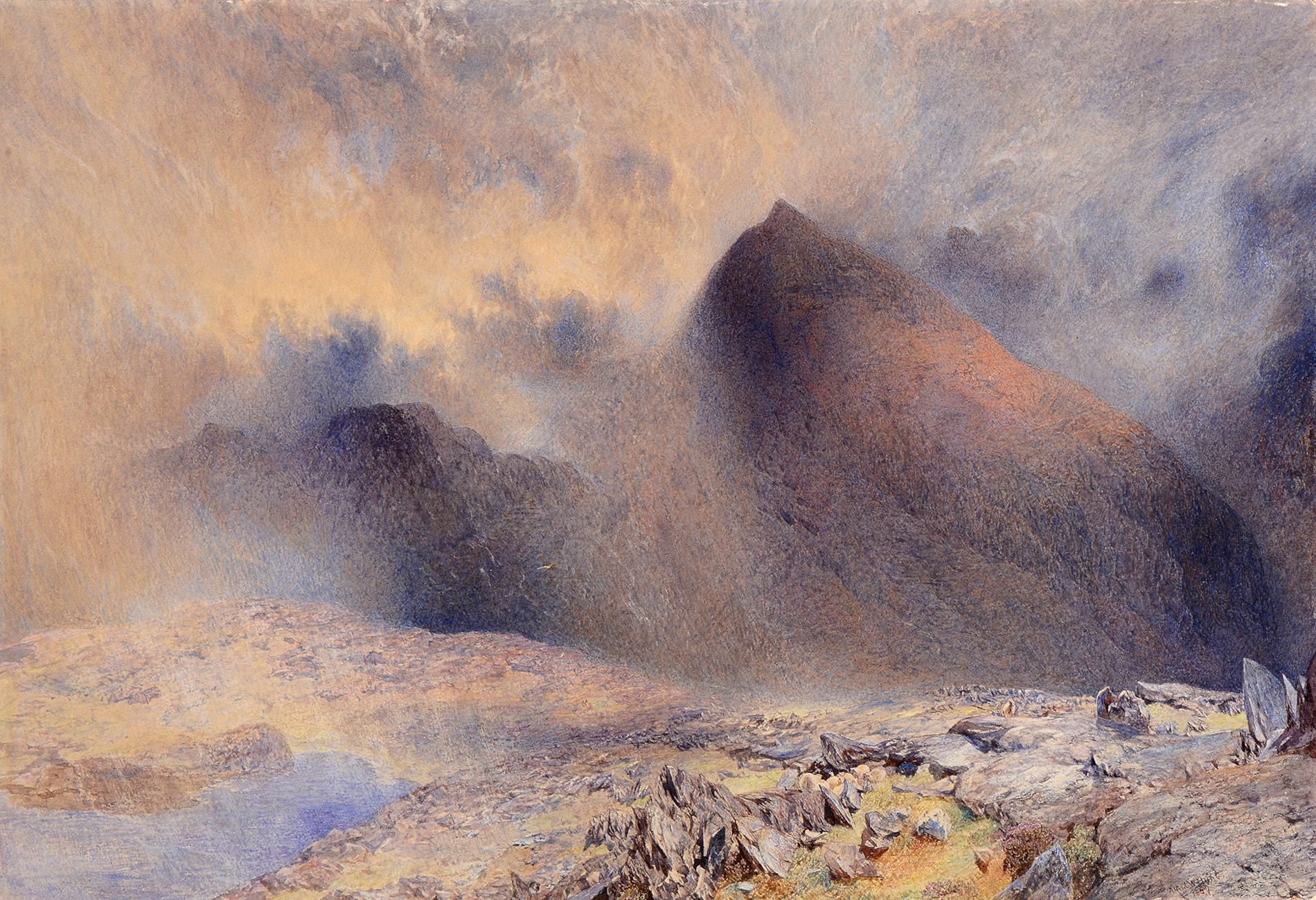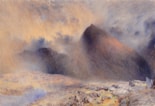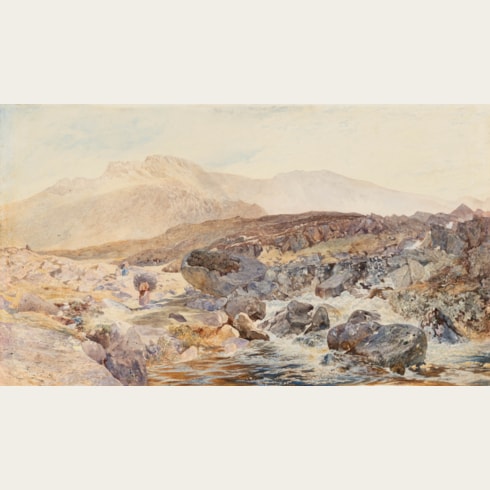Alfred William HUNT
(Liverpool 1830 - London 1896)
Mount Snowdon through Clearing Clouds
Sold
Watercolour, with scratching out.
Signed and dated Alfred W Hunt / 1857 at the lower right.
320 x 490 mm. (12 5/8 x 19 1/4 in.)
ACQUIRED BY THE J. PAUL GETTY MUSEUM, LOS ANGELES, CA.
Signed and dated Alfred W Hunt / 1857 at the lower right.
320 x 490 mm. (12 5/8 x 19 1/4 in.)
ACQUIRED BY THE J. PAUL GETTY MUSEUM, LOS ANGELES, CA.
This superb, atmospheric watercolour by Hunt is a view of Mount Snowdon, the highest mountain in Wales, which rises to 1,085 metres above sea level and dominates the surrounding Snowdonia National Park. This view is of the west flank of the mountain, looking towards the southeast. Hunt made several sketching trips to North Wales in the 1850’s, while studying at Oxford, perhaps at the suggestion of David Cox. At least one of these visits to Wales was financed by the Oxford printseller James Wyatt, who exhibited Hunt’s drawings in his shop on the High Street, and who seems to have developed a market for mountain views by the artist. One recent scholar has suggested that ‘Hunt’s particular interest in mountain subjects, treated with careful attention to their structure and geological character, and the physical processes which had formed the landscape, was perhaps fostered by the principal of the Liverpool Collegiate School, the Revd William Conybeare, who was a geologist and Bible scholar.’ Hunt must surely also have been inspired by the fourth volume of Ruskin’s Modern Painters, published in April 1856 and subtitled Of Mountain Beauty, in which the author extols the virtues of mountain subjects as worthy of serious artistic study in terms of their geology.
Between 1856 and 1858 Hunt produced a handful of paintings and watercolours of mountain views in Snowdonia, including the painting The Track of an Ancient Glacier in the Tate in London, completed in 1858, and two watercolour views of Cwm Trifaen with the Peak of Glyder Fach, one now in the Cleveland Museum of Art and the other in the Robertson Collection in Orkney; both watercolours are closely comparable to the present sheet in style and technique.
Allen Staley has noted that ‘[The] watercolours from the 1850s are Hunt’s freshest and strongest works. Their compositions seem to be the result of a direct confrontation with nature...’ The difficult working conditions borne by the artist at the time he produced this watercolour is perhaps best seen in a letter written to a friend in September 1857, while he was working in Snowdonia. In this letter, Hunt writes that ‘I am in the land of damp – of fog and mist – I know it to my cost. We have had nothing but...rain for the last fortnight – now the weather is holding up for a time, but the cold (in Cwm Trifaen) is unendurable. I’ve composed my epitaph – to be graven on the biggest stone of the biggest moraine there...As soon as I’ve extricated myself from Cwm Trifaen I shall run away hence...campaigning here is really no joke.’
Another large watercolour view of Mount Snowdon by Hunt, seen from a similar vantage point but further away from the mountain’s peaks, is in a private collection. While that watercolour, which is unsigned and undated, has previously been thought to be the work exhibited by Hunt at the Royal Academy in 1857 under the title ‘Snowdon after an April Hailstorm’, it is more likely that the present, signed and dated watercolour is the work in question. Of the watercolour exhibited at the Royal Academy in 1857, Ruskin wrote, ‘[it] is a very remarkable drawing, and the best study of sky that I can find this year; notable especially for its expression of the consumption of the clouds – not their driving away, but melting away in the warmer air.’ This description would also seem to relate much more closely to composition and tonality of the present sheet, than to the other watercolour of a similar view.
As Christopher Newall has perceptively written of Alfred William Hunt, ‘His work is a celebration of the beauty of the British landscape, with its extraordinary variety of aspect and constant fluctuation of atmospheric and meteorological effect. His paintings and drawings have the power to make the spectator want to see and experience the places represented, not so much to test the artist’s responses, but to share the delight he felt.’
Between 1856 and 1858 Hunt produced a handful of paintings and watercolours of mountain views in Snowdonia, including the painting The Track of an Ancient Glacier in the Tate in London, completed in 1858, and two watercolour views of Cwm Trifaen with the Peak of Glyder Fach, one now in the Cleveland Museum of Art and the other in the Robertson Collection in Orkney; both watercolours are closely comparable to the present sheet in style and technique.
Allen Staley has noted that ‘[The] watercolours from the 1850s are Hunt’s freshest and strongest works. Their compositions seem to be the result of a direct confrontation with nature...’ The difficult working conditions borne by the artist at the time he produced this watercolour is perhaps best seen in a letter written to a friend in September 1857, while he was working in Snowdonia. In this letter, Hunt writes that ‘I am in the land of damp – of fog and mist – I know it to my cost. We have had nothing but...rain for the last fortnight – now the weather is holding up for a time, but the cold (in Cwm Trifaen) is unendurable. I’ve composed my epitaph – to be graven on the biggest stone of the biggest moraine there...As soon as I’ve extricated myself from Cwm Trifaen I shall run away hence...campaigning here is really no joke.’
Another large watercolour view of Mount Snowdon by Hunt, seen from a similar vantage point but further away from the mountain’s peaks, is in a private collection. While that watercolour, which is unsigned and undated, has previously been thought to be the work exhibited by Hunt at the Royal Academy in 1857 under the title ‘Snowdon after an April Hailstorm’, it is more likely that the present, signed and dated watercolour is the work in question. Of the watercolour exhibited at the Royal Academy in 1857, Ruskin wrote, ‘[it] is a very remarkable drawing, and the best study of sky that I can find this year; notable especially for its expression of the consumption of the clouds – not their driving away, but melting away in the warmer air.’ This description would also seem to relate much more closely to composition and tonality of the present sheet, than to the other watercolour of a similar view.
As Christopher Newall has perceptively written of Alfred William Hunt, ‘His work is a celebration of the beauty of the British landscape, with its extraordinary variety of aspect and constant fluctuation of atmospheric and meteorological effect. His paintings and drawings have the power to make the spectator want to see and experience the places represented, not so much to test the artist’s responses, but to share the delight he felt.’
Born and raised in Liverpool, Alfred William Hunt studied classics at Oxford and became a Fellow of Corpus Christi College, combining academic and artistic careers until the early 1860s. His early work as a watercolourist was influenced by the example of David Cox, who was a friend of his father, the Liverpool landscape painter Andrew Hunt. In 1854 he exhibited for the first time at the Royal Academy in London, with a painting of the Lake District. From 1856 he was a member of the Liverpool Academy, where he exhibited until 1864, when he joined the Old Water-Colour Society in London. Hunt made several sketching trips to North Wales in the 1850s, while studying at Oxford, perhaps at the suggestion of Cox. A number of these early visits to Wales were financed by the Oxford printseller James Wyatt, who exhibited Hunt’s drawings in his shop on the High Street, and who seems to have developed a local market for mountain views by the artist. In the second half of the 1850s Hunt produced a handful of paintings and watercolours of mountain views in Snowdonia, notably the painting Cwm Trifaen (The Track of an Ancient Glacier) in the Tate collection in London. Other favoured sites for painting were in Yorkshire, Northumberland and around Durham, while he also made sketching tours in Germany and Switzerland – often tracing J. M. W. Turner’s earlier visits to these areas – as well as Scotland and the Lake District. In 1861 Hunt resigned his fellowship at Corpus Christi to marry and embark on an artistic career. For the next few years he lived in Durham, before moving to London in 1865.
Hunt preferred, as much as possible, to work on the spot, producing numerous sketches and colour studies that would be worked up into finished watercolours and paintings in the studio. (More than two hundred of the artist’s sketchbooks are today in the collection of the Ashmolean Museum in Oxford.) Like many artists coming of age in the 1850s, Hunt was profoundly influenced by reading John Ruskin’s Modern Painters, and one modern scholar has aptly described him as ‘perhaps the quintessential artist of the Ruskinian moment in Victorian painting.’ Hunt and Ruskin were to enjoy a friendship from the mid-1850s onwards, with Ruskin often praising the works which Hunt exhibited, although he was also at times quite critical of the artist’s precise technique.
The other great influence on Hunt was Turner, whose watercolour style, at least in his more finished work, the younger artist attempted to emulate. As the critic F. G. Stephens wrote of him in 1884, ‘Mr. Hunt is a true artist of Turner’s school, in fact the legitimate successor of Turner, but, except in strenuously and subtly endeavouring to delineate the effects of light, not his imitator.’ More recently, Andrew Wilton has noted that ‘there is considerable variety in Hunt’s work, and a lifelong dialogue with the protean Turner...his watercolour style is founded on the meticulous hatching and scrubbing that characterises Turner’s finished work in that medium, and rarely attempts the sort of breadth that he could not quite countenance in his admired Cox’s late work...His watercolour is usually enriched with bodycolour and gum, varied with scraping and scratching-out and, especially later on, subjected to a thorough surface-rubbing that half-veils the scenery in hazy light...These pictures are so rich that each one rewards detailed scrutiny, just as Ruskin demanded.’
Hunt’s watercolours are characterized by an abiding interest in intense colour and luminosity, allied with a meticulous technique and an insistence of working on the spot wherever possible. Although the minute detail and precise technique of his work was sometimes criticized by Ruskin as being too laboured, Hunt seems to have largely ignored the latter’s comments. Most critics admired the delicate technique, subtle tonality and brilliant effects of Hunt’s exhibited watercolours, which best evince his love of nature and feeling for the magnificence of the English landscape. Hunt published a personal account of ‘Modern English Landscape-Painting’ in the magazine The Nineteenth Century in May 1880, followed in February 1891 by a second article entitled ‘Turnerian Landscape – An Arrested Art’, in the same publication. A major retrospective exhibition of 137 paintings and watercolours by Hunt was mounted at the Fine Art Society in London in 1884, while in 1893 another exhibition of his work was held in Chicago, which the artist duly attended. In 1897, the year after Hunt’s death, three large memorial exhibitions of his work were organized; at the Old Water-Colour Society and the Burlington Fine Arts Club in London and the Walker Art Gallery in Liverpool. More recently, a major exhibition of Hunt’s oeuvre was mounted at the Ashmolean Museum in Oxford and the Yale Center for British Art in New Haven in 2004.
Hunt preferred, as much as possible, to work on the spot, producing numerous sketches and colour studies that would be worked up into finished watercolours and paintings in the studio. (More than two hundred of the artist’s sketchbooks are today in the collection of the Ashmolean Museum in Oxford.) Like many artists coming of age in the 1850s, Hunt was profoundly influenced by reading John Ruskin’s Modern Painters, and one modern scholar has aptly described him as ‘perhaps the quintessential artist of the Ruskinian moment in Victorian painting.’ Hunt and Ruskin were to enjoy a friendship from the mid-1850s onwards, with Ruskin often praising the works which Hunt exhibited, although he was also at times quite critical of the artist’s precise technique.
The other great influence on Hunt was Turner, whose watercolour style, at least in his more finished work, the younger artist attempted to emulate. As the critic F. G. Stephens wrote of him in 1884, ‘Mr. Hunt is a true artist of Turner’s school, in fact the legitimate successor of Turner, but, except in strenuously and subtly endeavouring to delineate the effects of light, not his imitator.’ More recently, Andrew Wilton has noted that ‘there is considerable variety in Hunt’s work, and a lifelong dialogue with the protean Turner...his watercolour style is founded on the meticulous hatching and scrubbing that characterises Turner’s finished work in that medium, and rarely attempts the sort of breadth that he could not quite countenance in his admired Cox’s late work...His watercolour is usually enriched with bodycolour and gum, varied with scraping and scratching-out and, especially later on, subjected to a thorough surface-rubbing that half-veils the scenery in hazy light...These pictures are so rich that each one rewards detailed scrutiny, just as Ruskin demanded.’
Hunt’s watercolours are characterized by an abiding interest in intense colour and luminosity, allied with a meticulous technique and an insistence of working on the spot wherever possible. Although the minute detail and precise technique of his work was sometimes criticized by Ruskin as being too laboured, Hunt seems to have largely ignored the latter’s comments. Most critics admired the delicate technique, subtle tonality and brilliant effects of Hunt’s exhibited watercolours, which best evince his love of nature and feeling for the magnificence of the English landscape. Hunt published a personal account of ‘Modern English Landscape-Painting’ in the magazine The Nineteenth Century in May 1880, followed in February 1891 by a second article entitled ‘Turnerian Landscape – An Arrested Art’, in the same publication. A major retrospective exhibition of 137 paintings and watercolours by Hunt was mounted at the Fine Art Society in London in 1884, while in 1893 another exhibition of his work was held in Chicago, which the artist duly attended. In 1897, the year after Hunt’s death, three large memorial exhibitions of his work were organized; at the Old Water-Colour Society and the Burlington Fine Arts Club in London and the Walker Art Gallery in Liverpool. More recently, a major exhibition of Hunt’s oeuvre was mounted at the Ashmolean Museum in Oxford and the Yale Center for British Art in New Haven in 2004.
Provenance
Charles Nobbs, York
Anonymous sale, Leyburn, Tennants, 23 November 2006, lot 777
The Maas Gallery, London, in April 2007
Christopher Cone, Whitby.
Literature
Probably John Ruskin, Notes on Some of the Principal Pictures Exhibited in the Rooms of the Royal Academy and the Society of Painters in Water-Colours, Etc., No.III – 1857, London, 1857; reprinted in E. T. Cook and Alexander Wedderburn, ed., The Works of John Ruskin, Vol.XIV: Academy Notes, Notes on Prout and Hunt and other Art Criticisms 1855-1888, London, 1904, p.117.
Exhibition
Probably London, Royal Academy, 1857, no.761 (‘Snowdon after an April Hailstorm’).





